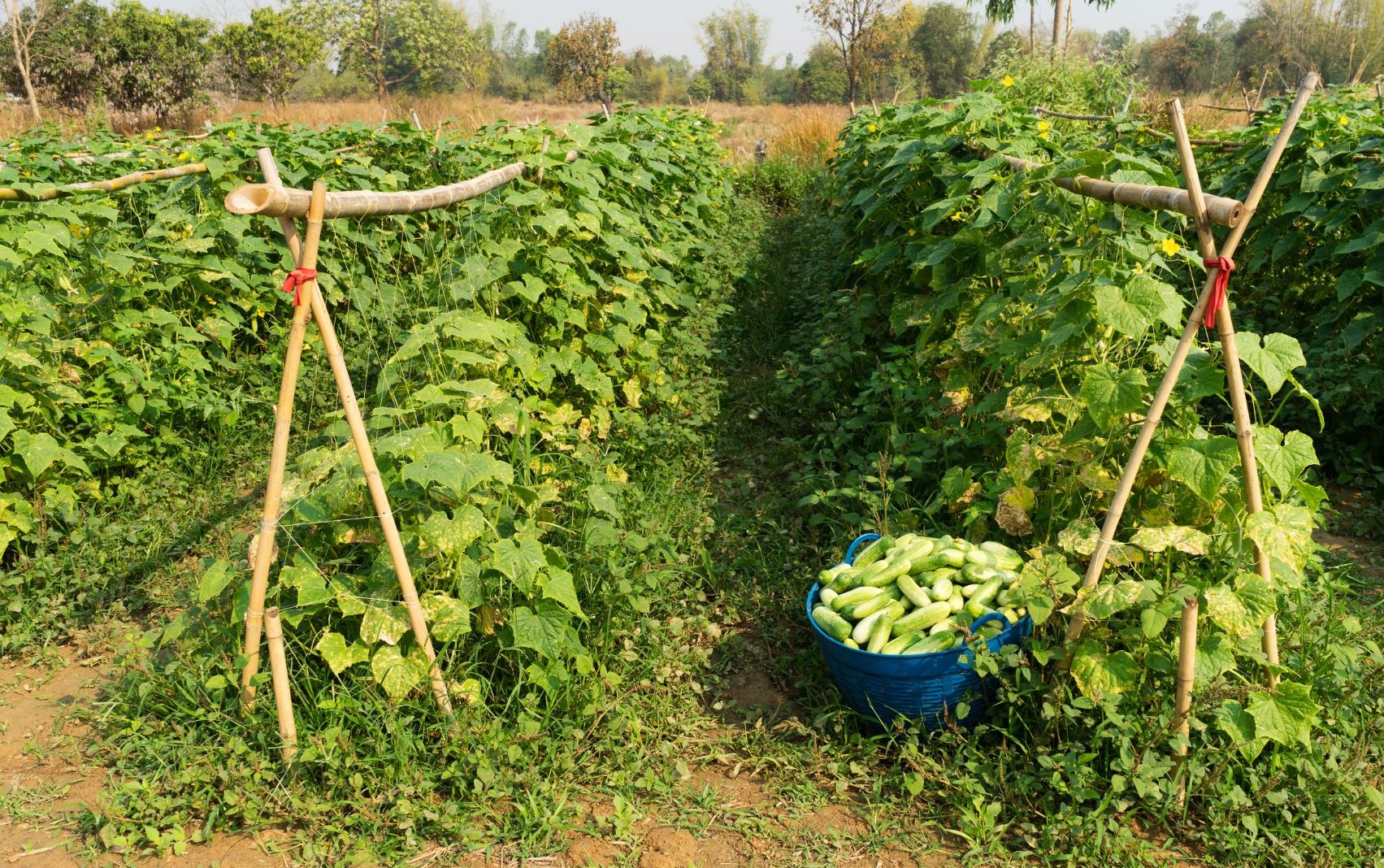Cucumber Pests and Diseases

This post is also available in:
This post is also available in:
![]() Español (Spanish)
Español (Spanish) ![]() Français (French)
Français (French) ![]() Deutsch (German)
Deutsch (German) ![]() हिन्दी (Hindi)
हिन्दी (Hindi) ![]() Ελληνικά (Greek)
Ελληνικά (Greek)
Cucumber Plant Protection
Major Cucumber pests
The most known and common pests in cucumber cultivation are (1, 4, 5, 7);
- Cucumber beetle (stripped and spotted, Diabrotica undecimpunctata). Its control is very important concerning the prevention of bacterial wilt. The adults feed on the small seedlings, so they are extremely susceptible.
- Aphids (Aphis gossypii). Some common symptoms are deformed and curled leaves, as well as the presence of a sticky honeydew or black, sooty mold.
- Spider mites (Tetranychus urticae). The most common symptoms appear on the leaves (fine stippling, yellow or brown color, and yellow, orange, or red dots on the underside).
- Squash vine borer (Melittia cucurbitae). Gradual wilting of plants.
- Squash bug (Anasa tristis). Leaves have specks that turn yellow and then brown.
- White fly (Bemisia tabaci). Leaves turn yellow.
- Cutworms (Agrotis ipsilon, Peridroma saucia). Leaves with feeding damage.
- Pickleworms (Diaphania nitidalis). Leaves with feeding damage.
- Leafhopper (Empoasca fabae). White stippling on the upper surface of leaves.
Of course, after years of research, farmers have at their disposal many pesticides that are suitable for controlling the pests above. However, many growers choose to use other techniques, such as applying a floating row cover over young transplants or seedlings (1, 3). Before applying any pesticide, you have to read the label instructions and follow them step by step. You must always consult your local licensed agronomist. Moreover, it’s better to apply the pesticides late in the afternoon to avoid harming the bee population (5). In cucumber cultivation, animal pests are not as great a problem as it happens in watermelons.
The most important Cucumbers diseases
Except for pests, some diseases can significantly affect cucumber cultivation. Some of the most known and common cucumber diseases are (1, 2, 6, 7, 8);
- Downy mildew (Peronospora parasitica). Leaves with yellow angular lesions.
- Powdery mildew (Erysiphe, Podosphaera, Oïdium, Leveillula). It can be prevented by maintaining enough space between plants, ameliorating air circulation – controlling weeds, using drip irrigation, and using fungicides appropriately. Powdery white patches on leaves.
- Anthracnose (Colletotrichum orbiculare). Leaves with brown lesions with yellow haloes.
- Angular leaf spot (Pseudomonas syringae pv. lachrymans). Water-soaked angular spots on leaves, stems, and fruits.
- Gummy stem blight (Didymella bryoniae). Leaves with brown-black and water-soaked spots.
- Bacterial wilt (Pseudomonas solanacearum). An indication could be the presence of striped or spotted cucumber beetles in the field. Leaves margins are green to yellow and brown.
- Fusarium wilt (Fusarium oxysporum). Yellow leaves and wilting.
- Mosaic viruses (Cucumber mosaic virus-CMV). Green and yellow mottling on leaves and curling leaves.
- Target spot (Corynespora cassiicola). Round lesions on older leaves.
- Belly rot (Rhizoctonia solani). There are water-soaked and tan to brown lesions on the underside of the fruit.
To eliminate diseases’ establishment and spread, we can use adequate cultivation practices. We have to keep in mind that a great number of pathogens (fungal, bacterial, nematode) can survive in old crop residues, as well as in the soil. A proposed practice is to apply crop rotation for at least 3 years by cultivating non-cucurbit crops. This way pathogen levels will be reduced. When nematodes are the main problem, the ideal option is using grass crops for crop rotation. Moreover, it is very important to have well-drained soil. We can improve soil drainage by using free-standing raised beds. We have to avoid planting in spots where foliar or virus diseases have already been established. Cleaning the equipment properly is also important, in order not to spread pathogens from one field to another. Some diseases, such as anthracnose or gummy stem blight can be transmitted by seed. This way clean fields can be damaged. It is always recommended not only to buy certified seeds but also to treat them with a fungicide before planting. Growers have to remember that most foliar diseases are easily spread by water drops and are significantly favored by long periods of high humidity levels. Thus, it’s safer to apply drip irrigation and/or avoid frequent sprinkler irrigations. Another recommended practice is not to be late to till the fields after harvesting them. This way the roots and residues of the cucumber will decompose more easily and quickly. Finally, a grower should always use disease-resistant varieties that can easily find in the market (4).
References
- https://ipm.missouri.edu/meg/2014/3/Cucumber-A-Brief-History/
- https://www.britannica.com/plant/cucumber
- https://www.rhs.org.uk/vegetables/cucumbers/grow-your-own
- https://extension.okstate.edu/fact-sheets/cucumber-production.html
- https://vric.ucdavis.edu/pdf/cucumber.pdf
- https://s3.wp.wsu.edu/uploads/sites/2071/2014/04/Growing-Cucumbers-FS096E.pdf
- https://hgic.clemson.edu/factsheet/cucumber/
- https://extension.umn.edu/disease-management/bacterial-wilt
Further reading
Cucumber History, Plant Information, Interesting facts, and Nutritional Value
How to grow cucumber for profit – Commercial cucumber cultivation
Principles for selecting the best Cucumber Variety
Cucumber Soil preparation, Soil, and Climate requirements, and Seeding requirements
Cucumber Irrigation – Water Requirements and Methods
Cucumber Fertilization Requirements and Methods
Cucumber Pests and Diseases








































































